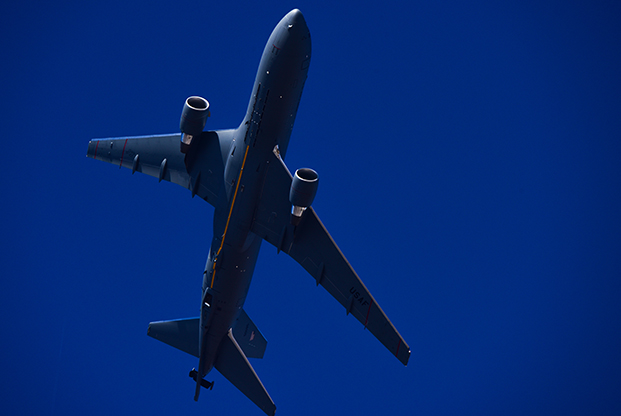
A KC-46A Pegasus circles over the flightline prior to landing Jan. 25, 2019, at McConnell Air Force Base, Kan. Air Force photo by A1C Skyler Combs.
The Air Force is reviewing its emergency training procedures and analyzing past autopilot-related mishaps following two crashes of new Boeing 737 MAX 8 aircraft, but doesn’t believe that its KC-46 tanker—which has a similar Maneuvering Characteristics Augmentation System (MCAS)—currently endangers military aircrews.
Chief of Staff Gen. David Goldfein has “directed Air Force leaders to ensure we have adequate training in our aircraft emergency procedures—and simulator training,” Air Force spokeswoman Ann Stefanek said in an email. “As far as autopilot systems, most USAF aircraft have some version of autopilot, with varying levels of complexity. At this time, the [Air Force] has no indication of problems with Air Force aircraft similar to what has been reported with the MAX,” she said.
“The KC-46 is based on the [Boeing] 767-2C model” and has “important differences with the software employed” on the 737 MAX 8s in recent crashes, the service said in written responses to questions from Air Force Magazine.
The Air Force is awaiting the results of a Boeing review of the 737 MAX 8 MCAS system, and “if there are any findings that affect the KC-46, the Air Force will take appropriate measures to address the findings,” it asserted. “The 767 family has not been impacted” by the MCAS issue, the service maintained.
Boeing was criticized during the KC-X competition for cobbling together a “Frankentanker,” as its competitor Airbus charged, using physical elements and software from several different aircraft in its lineup to develop what became the KC-46.
The 737 MAX 8 uses an MCAS to deal with weight and balance issues driven by the narrow ground clearance of its engines. It will automatically direct a nose-down attitude to prevent the aircraft from stalling if the angle of attack is too high. The KC-46 uses a similar system because the weight and balance of the tanker shifts as it redistributes and offloads fuel. The KC-46 has a two-sensor MCAS system, which “compares the two readings,” the Air Force said.
Moreover, while the MAX 8 MCAS will reset and come back on automatically, the KC-46’s system is “disengaged if the pilot makes a stick input,” according to the Air Force. “The KC-46 has protections that ensure pilot manual inputs have override priority.”
The service declined to comment on whether the KC-46 MCAS system was in any way shaped by the MAX 8 program. “The KC-46 program office does not have insight and oversight of 737 MAX 8 commercial aircraft or lessons learned,” the service said.
To date, the Air Force has observed “no unexpected activations of the stall prevention system” on the KC-46 during testing, “or situations similar to what is known about the two MAX 8 crashes.” The service “does not see MCAS as a concern at this time.”
USAF’s training review is not focused on specific problems, but represents due diligence as aircraft safety questions arise in the mishaps’ aftermath, the service noted.
The Air Force has offered the Federal Aviation Administration “full support and assistance with our USAF safety resources,” Stefanek said.
Two Boeing 737 MAX 8 aircraft have crashed in recent months—a Lion Air flight in Indonesia last October and an Ethiopian Airlines crash near Addis Ababa earlier in March—prompting global airline authorities, including the FAA, to ground the aircraft.
CNN first reported the Air Force’s training review March 20, and though attention has focused on the Boeing-made C-17, VC-25, and KC-46, USAF officials said March 21 the review is not specific to any airframe.
“The USAF does not fly the models of aircraft involved in the recent accidents, but we are taking this opportunity to exercise due diligence by reviewing our procedures and training as part of our normal and ongoing review process,” the service said.
